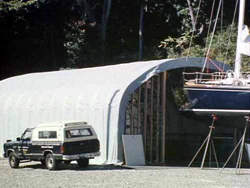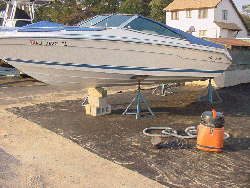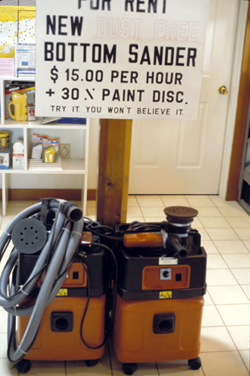New York Sea Grant's
Marina Pollution Prevention Web Site
Section 2: Painting
& Fiberglass Repair
- Sanding & Scraping
Potential Environmental Impacts:
Hull paints can contain hazardous materials including heavy metals
(copper, tin and zinc) and volatile organic compounds (VOCs).
Sanding chips and dust that fall onto the ground can enter a marina
basin through stormwater runoff. Paint chips and sanding debris
can be particularly dangerous when shellfish ingest them, and
the shellfish are ingested by other animals.
Best
Management Practices:
Conduct sanding and scraping away from the water's edge. Designate
an upland area for debris-producing maintenance  such
as scraping, sanding, and sandblasting. The boat maintenance area
can be a temporary structure or plastic sheeting provided to minimize
the spreading of dust and windblown material. The work area should
be well marked with signs.
such
as scraping, sanding, and sandblasting. The boat maintenance area
can be a temporary structure or plastic sheeting provided to minimize
the spreading of dust and windblown material. The work area should
be well marked with signs.
Place drop
cloths or tarps under vessels when sanding or scraping. Weight
the bottom edges of tarps and drop clothes to keep them in place.
 Consider
installing an impervious pad for conducting debris-producing maintenance.
Consider
installing an impervious pad for conducting debris-producing maintenance.
Clean up all
debris, trash, sanding dust, and paint chips immediately following
any maintenance or repair activity. When sanding or grinding hulls
over a paved surface, vacuuming or sweeping loose paint particles
is the preferred cleanup method. Do not hose the debris away.
Avoid scraping
or sanding on windy days, unless conducting activity in an enclosed
maintenance structure.
Use dustless
or vacuum sanders when sanding. These tools can collect over 98%
of dust generated instead of releasing it into the air. Workers
can use this equipment without full suits or respirators and have
less cleanup when the job is done saving time and money. For manufacturers
of dustless vacuum sander equipment, click
here.
Require customers
and contractors to use dustless or vacuum sanders when working
in the marina. Rent or loan the equipment to them.
 Post
signs indicating the availability of the dustless or vacuum sanders.
Post
signs indicating the availability of the dustless or vacuum sanders.
Provide a
collection drum for the dust from vacuum sanders and other scraping
debris.
Restrict or
prohibit sanding and scraping boats which are in the water, to
the greatest extent practicable.
If sanding,
scraping or grinding must take place while the boat is in the
water, use tarps and sheeting installed between the vessel being
worked on and the floats or walking surface to prevent dust, paint
chips, debris, or other materials from falling or being blown
into the water. The sheeting should have a tight seal to the vessel
and adjacent surfaces to prevent leakage of particulates outside
the work area. Remove the sheeting carefully to prevent the loss
of accumulated waste material into the water.
Regulatory
Issues:
A hazardous
waste determination must be conducted on paint sandings, dust
and chips to establish whether or not their disposal is subject
to hazardous waste regulations. To determine if they are hazardous,
the generator must either have waste materials tested or utilize
reliable "knowledge of process" information for the
waste (if available) [40 CFR 262.11, click
here]. Such information could include testing by
haulers, or studies by industry trade groups. For more information
on New York hazardous waste testing requirements, click
here. If they are hazardous, they must be managed
in accordance with hazardous waste storage requirements [40
CFR 262.11, click
here]. For more information on New York's Hazardous
Waste Regulations and storage requirements, click
here.
If there is
a storm water discharge from your facility and you scrape or sand
hulls outdoors you may have to register for a General Permit for
the Discharge of Storm Water Associated with Industrial Activity
("Storm Water General Permit"). For more information
on storm water permitting in New York, click
here.

